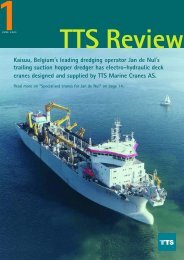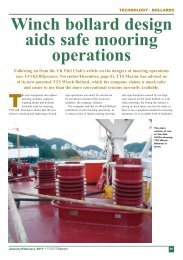Mechanical support linkspan - TTS Group ASA
Mechanical support linkspan - TTS Group ASA
Mechanical support linkspan - TTS Group ASA
Create successful ePaper yourself
Turn your PDF publications into a flip-book with our unique Google optimized e-Paper software.
POWER TO MOVE<br />
www.ttsgroup.com<br />
<strong>Mechanical</strong> <strong>support</strong> <strong>linkspan</strong><br />
The function of <strong>linkspan</strong>s is to level the height difference between the quay and<br />
the cargo deck of the vessel in order to provide smoother, safer and faster access<br />
for loading and unloading. The <strong>TTS</strong> mechanical <strong>support</strong> <strong>linkspan</strong>, operated by<br />
lifting equipment, for example hydraulic cylinders, provides an access way to the<br />
main deck or the upper deck of the vessel. When linking to the main deck, it is<br />
normally positioned to accommodate the vessel’s ramp, but it can also be rested<br />
on the vessel’s ledge.<br />
PORT AND LOGISTICS
MECHANICAL SUPPORT LINKSPAN<br />
The mechanical <strong>support</strong><br />
<strong>linkspan</strong> is suitable for use<br />
across different ranges of tidal<br />
variation. Where variation is<br />
small, the <strong>linkspan</strong> is usually<br />
operated at a fixed level,<br />
specified according to average<br />
water levels and vessel type.<br />
The operator activates the<br />
<strong>linkspan</strong> to a preselected level,<br />
the parking cleat automatically<br />
unlocks, the <strong>linkspan</strong> then<br />
manoeuvres and locks at the<br />
correct level.<br />
With greater tidal variation,<br />
the <strong>linkspan</strong> is able to follow<br />
the tide while being used to<br />
<strong>support</strong> the vessel’s ramp.<br />
The operating panel can be<br />
programmed to accommodate<br />
various types of vessel such<br />
that the <strong>linkspan</strong> is levelled<br />
to fit the ship’s deck when it<br />
arrives in port.<br />
If a vessel has no ramp, the<br />
operator can manoeuvre the<br />
<strong>linkspan</strong> onto the vessel’s<br />
ledge. It can then be switched<br />
to ‘floating’ mode in order to<br />
Picture courtesy of Albert Richardson<br />
<strong>TTS</strong> Port Equipment AB<br />
Kämpegatan 3<br />
SE-411 04 Göteborg<br />
Sweden<br />
Tel: +46 31 725 79 00<br />
Fax: +46 31 725 78 04<br />
info@tts-port.se<br />
www.ttsgroup.com<br />
<strong>TTS</strong> Handling Systems AS<br />
Holterkollvn 6,<br />
NO-1441 Drøbak<br />
Norway<br />
Tel: +47 64 90 79 10<br />
Fax: +47 64 93 16 63<br />
info@tts-hs.no<br />
<strong>TTS</strong> Liftec Oy<br />
Sorkkalantie 394<br />
33980 Pirkkala<br />
Finland<br />
Tel: +358 3 3140 1400<br />
Fax: +358 3 3140 1444<br />
sales@tts-liftec.fi<br />
follow the vessel’s movement.<br />
Extended access ramps<br />
can be provided to ensure a<br />
smooth flow of traffic when<br />
the <strong>linkspan</strong> is used for access<br />
to the upper deck.<br />
The mechanical <strong>support</strong><br />
<strong>linkspan</strong> enables more efficient<br />
loading and unloading of<br />
two-deck vessels, and helps<br />
reduce the turnaround time of<br />
cargo vessels in port.<br />
PORT AND LOGISTICS


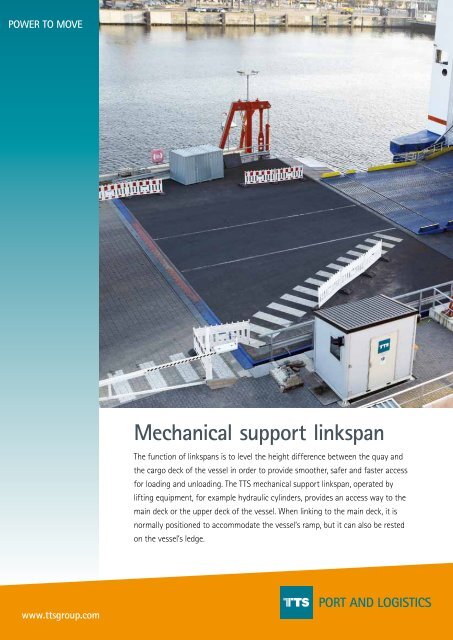


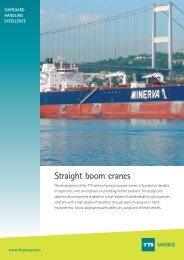

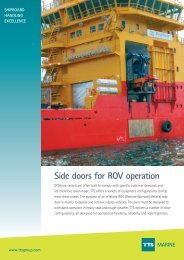
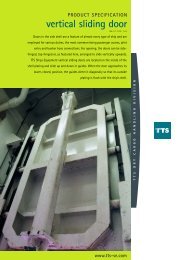
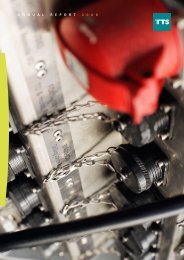


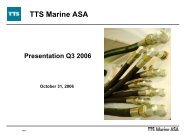
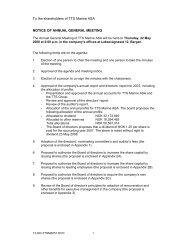
![2012.MasterPresentation_final [Compatibility Mode] - TTS Group ASA](https://img.yumpu.com/4612021/1/190x146/2012masterpresentation-final-compatibility-mode-tts-group-asa.jpg?quality=85)
